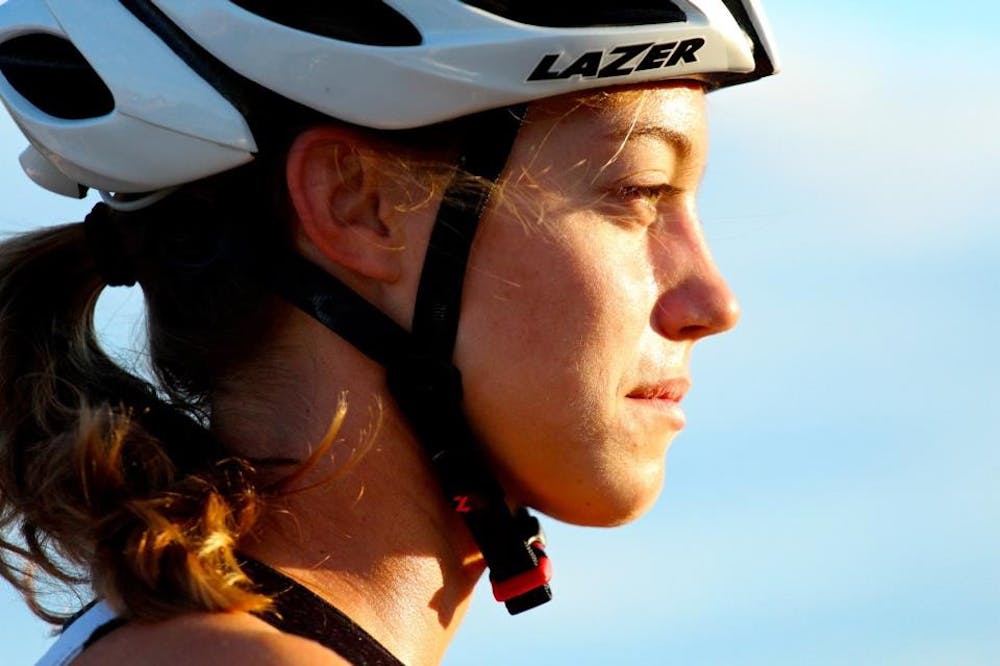Usually all athletes cringe at the sight of a hospital. That means weeks to months not doing the sport you love at least; you tell yourself “no, not going to happen,” but it’s usually undisputable. Then again, what if it shed a different light of opportunity? Under the Arizona sun, Lindsey Ryder can’t help but to be thankful for her injury.
Ryder, now a sophomore biomedical engineering major, looks back. In high school, she had swam on the swim team and ran track. From there, in order to “just keep in shape,” Ryder had run and swam several times a week during her first semester at Arizona State University. From running as frequently, she then developed in a stress fracture in her foot; she was confined to swimming at that point.
“Someone in one of my classes asked me what I did to my foot,” Ryder remembers. “Immediately they insisted that I start riding a bike and join the triathlon club. They let me borrow a bike to get started…I was actually able to hang on, barely.”
Ryder “jumped in with two feet,” using this alternative way of staying in shape for all it was worth. This was the rehabilitation she needed. Physically, it aided in her recovery, but mentally, she had her mind set out for something new. According to Ryder, “at that point, I fell in love with biking and the idea of triathlons, combining three sports into one.”
Everything she had done was now connected—swimming, running and now biking. From there, she joined the ASU cycling and triathlon club.
“Looking back at my high school years, I have no idea why I was complaining about such a short race!” Ryder says. She made the transition from a two and a half minute track race to a two-hour Olympic standard course.
She had her mind fixated on the goal to grow. She would neither complain nor slack. When Ryder felt like she was slowing down, she would just think of all of her rivals and teammates and “imagine what they would do during this workout.”
“Would they be slacking? Who knows, but I definitely won’t because they are the people I want to beat,” Ryder says.
Ryder not only pushes herself but others on the team as well. Allysa Seely, a graduate student in interdisciplinary studies and integrated health modalities, had been Ryder’s first training partner; they still train together today.
“She’s (Lindsey’s) determined. She does not go down without a fight,” Seely says. “We help each other stay focused and stay dedicated in accomplishing our goals.”
Friendly competition stems from training with her teammates. Ryder not only trains with Seely but with the men’s side of the team as well. She joins them because she can push herself and because her competitive side kicks in.
“I enjoy being the only girl at these workouts because there is no one to compare myself to,” Ryder says. “I push myself to the max just trying to keep up and make the guys work for their victory. As a whole, I can beat half of them but that might change when they read this. It pushes me and pushes them, because heaven forbid, they get beat by a girl.”
Whether it is competing against her opponents or a little friendly completion from her teammates, Ryder founded her triathlon passion by pushing herself. Her set back set her forward, whether she knew it at the time or not.
“We all know it when we come together and workout as a team,” Ryder says. “We can hold each other accountable and exceed limits that would have never been pushed had we been alone; knowing that guy standing right next to you feels the same pain.”
For that pain, Ryder’s motivation derives from her faith in God and from her teammates. It is all about pushing herself that extra step. Recently, Ryder finished second place in the Pumpkinman Triathlon and looks to compete up-top the leader board in more events.
“One of my friends that I met at a Colorado State University triathlon training camp last summer recently made the comment to me, ‘Where in the world did that come from?’ referring to my second place finish at Pumpkinman. I told him that, ‘it was always there, I just had to find it.’”
Who knew she would’ve found “it” through a broken bone.
You can contact me at bcapria@asu.edu.





